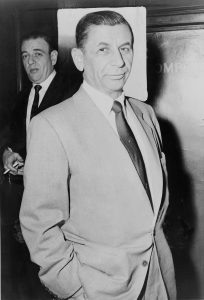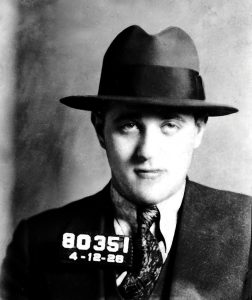For most of its history, Northern Kentucky was a decided also-ran when it came to immorality. From 1880 until 1920, Cincinnati, controlled by “Boss” Cox’s criminal syndicate, was a wide-open city with a thriving tenderloin, dozens of gambling dens, and ubiquitous bootleg booze. Toss enough bribes into Boss Cox’s desk drawer and you could, literally, get away with murder.
Nestled so near to “Sin-sin-naughty,” some moral stain was bound to spread across the Ohio River. In 1900, The Cincinnati Commercial Tribune had the nerve to slander Covington as “Spotty Town” due to a few gambling joints that wouldn’t have raised an eyebrow on the other side of the Suspension Bridge. Newport, saddled with the nickname “Little Mexico,” declared in 1933 that criminal enterprise had been banished forever from its confines. How little did they know.

Photograph by Al Ravenna, World Telegram Staff Photographer, public domain, Wikimedia Commons
On the northern bank of the river, Cincinnati’s unsavory underworld succumbed to a series of societal shifts. The U.S. Army shuttered Cincinnati’s red-light district during World War I. Prohibition recalibrated the distribution and consumption of alcohol. The Cox machine sputtered into extinction as the Boss’s successors failed to mirror his ironclad finesse. Cincinnati voters elected a Charterite council in 1925 who established a squeaky-clean city manager system. Between 1915 and 1935, Cincinnati earned a reputation as the best governed, least corrupt city in America.
Simultaneously, certain operators in Northern Kentucky—especially Newport—recognized a substantial opportunity to franchise vice. Assisted by major players in organized crime such as Meyer Lansky, Mo Dalitz, and Bugsy Siegel, casinos and brothels sprouted like mushrooms throughout the transpontine communities. For more than 30 years, the south shore of the Ohio River eclipsed the shameless criminality that had once defined Cincinnati. When George Remus, Cincinnati’s “King of the Bootleggers,” went to prison, where did his minions relocate? To Newport, of course.
Hand it to Northern Kentucky, three decades of sleaze and corruption were populated by some colorful personalities with names right out of the comic books: Frank “Screw” Andrews, Clarence “Cueball” Thomas, Johnny “TV” Peluso, and “Sleepout” Louis Levinson (the original Sleepout Louie).
By 1950, according to The Cincinnati Enquirer, Newport boasted seven casinos, eight gambling clubs, a passel of “bust-out joints” (minor-league gaming dens) and more than a dozen high-end brothels. One estimate claimed Newport operatives raked in $30 million in illegal gambling each year throughout the 1950s. Almost every taxi driver in Cincinnati earned tips for ferrying fares to Kentucky’s dens of iniquity.

Photograph courtesy New York Police Department, public domain, Wikimedia Commons
According to legend, Sin City collapsed after George Ratterman, a reform candidate for Campbell County sheriff, was found in bed with a stripper named (you can’t make this stuff up) April Flowers. The botched frame-up was so blatantly contrived, the syndicate faded away out of sheer embarrassment, or so goes the fable.
In reality, the world had changed yet again. Gambling’s future drifted west to Las Vegas. The end of prohibition unleashed a flood of heroin and other drugs. When the big money exited Northern Kentucky, the remaining sleaze lay exposed to a new broom of upright administration.
Folks nostalgic for that colorful era still spend their money in Newport, but not for hot action at the casino. They register for the Gangster Tour. Tickets are $29 and it’s rated PG-13.





Facebook Comments